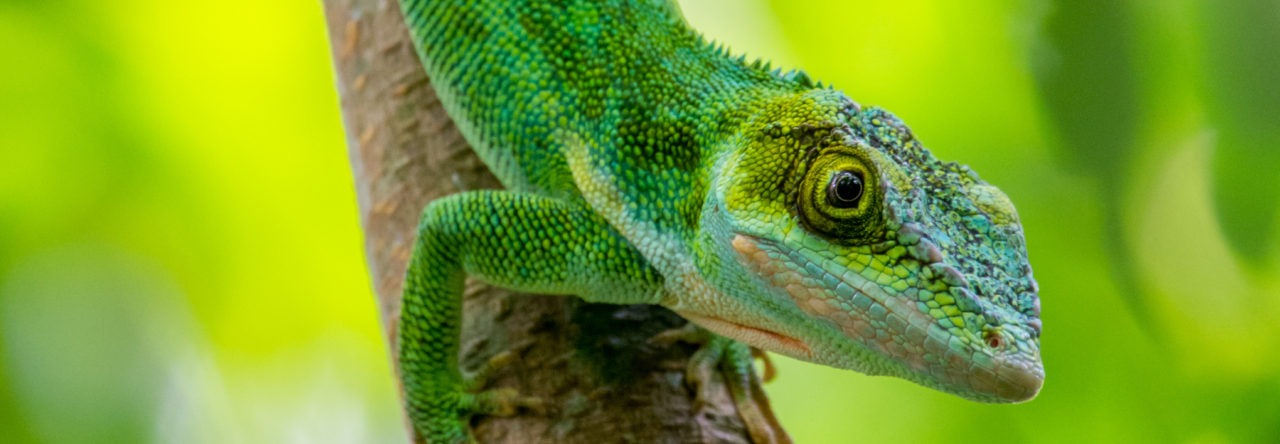Some weeks ago, a paper I wrote on the display behaviour and morphology of fan-throated lizards was published early online at the Journal of Herpetology. Some unfortunate timing meant that my paper did not incorporate these lizards’ new taxonomy, recently published by V. Deepak and colleagues. In this post, I’m going to summarize my results, and explore them in the context of what we now know about Sitana (Agamidae) systematics.
Male fan-throated lizards (surprise, surprise) have fans under their throats that are displayed in a manner analogous to the Anolis dewlap. The appearance of the throat-fan varies dramatically across this group, from small and mostly white to large and blue, black, and orange. I wanted to answer two broad questions
- Does display behaviour vary with throat-fan morphology? In other words, if you have different tools with which to communicate, do you communicate differently?
- Can we examine morphological and environmental variation to deduce anything about how this variation in throat-fan morphology has evolved?

Figure 1 from my paper, showing sampled sites and throat-fan variants.
To address these two questions, I measured the display behaviour, morphology, and environment of eight populations of lizards, from three “throat-fan variants.” I found the following:
- The main axis of variation in display behaviour differed between the coloured-fan variant and everybody else. Displays were fewer and longer in the coloured-fan variant, and included more head twists. The same axis of display behaviour did not differ between the white-fan and the intermediate-fan variants, though there was variation in the frequency of head-bobs across populations with different-sized throat-fans. These differences in display behaviour make sense in light of morphology. Head twisting was more frequent in the variant with a large blue section on the throat-fan that appears iridescent. Head-bobs, which often co-occur with a fully extended throat-fan, were more frequent in the variant(s) with smaller throat-fans (see Figure 6 in my paper for more).
- Throat-fan elaboration (both size and colour) was paired with increased male-biased sexual size dimorphism, suggesting sexual selection as a likely selective force driving throat-fan variation.
- Habitat structure did not co-vary with throat-fan morphology, suggesting that the visual environment is unlikely to play much of a role in the maintenance of this variation in throat-fan morphology. But because these lizards all persist in human-modified landscapes, it is difficult to discern how important the visual environment was for the origin of dewlap diversification in this group.

Figure 2 from Deepak et al. 2016.
Based on geography, I can tell that all three of the coloured-fan variant populations I sampled belong to the newly described Sarada darwinii. The white-fan populations are Sitana laticeps and Sitana spinaecephalus (+ one population I’m not sure about), and the northern and southern intermediate-fan populations are Sitana ponticeriana and Sitana visiri respectively. Recast in terms of these species delimitations, I found that:
- Display behaviour differs between the genera Sitana and Sarada. It doesn’t vary consistently with species within Sitana, though variation in head-bobbing should be explored further.
- There are two broad possibilities for throat-fan evolution in the group. One possibility is that throat-fan elaboration and a shift towards male-biased SSD has evolved independently twice, once in Sarada (Clade 1) and once in the South India/Sri Lanka clade (Clade 3 in the phylogeny) in Sitana. The other possibility is the reduction of dewlap size and colour in the west Indian Sitana clade (Clade 2). This question won’t be definitively answerable until we have a phylogeny that includes the remaining north-eastern species of Sitana as well as more species of the sister genus Otocryptis, which also vary in the presence and morphology of the throat-fan.
Before knowing about the phylogeny, I predicted that throat-fan elaboration had evolved twice in fan-throated lizards, based on a suite of differences between the coloured-fan variant (now Sarada) and the intermediate-fan variant (now Sitana Clade 3). The main ones are:
- Different display behaviour.
- Different allometric relationships between body size and throat-fan size, suggesting different ways in which throat-fans have gotten big.
- Different spectral reflectances from the blue and orange patches, plus the presence/absence of black on the throat-fan.
- The ability of Sitana, but not Sarada, to turn “on” and “off” the blue colour on their throat-fans (more about this in a future post!).
These differences now lead me to favour the first of the two possibilities outlined above: repeated, somewhat parallel evolution of throat-fan elaboration, as opposed to the loss of an elaborate throat-fan. Given that the sister genus Otocryptis has also either evolved or lost a throat-fan (throat-fans are present in O. nigristima and O. wiegmanni but not O. beddomi), this group is positively rife with lability in display evolution, offering all sorts of exciting possibilities for future research!




 We’ve seen
We’ve seen 





















